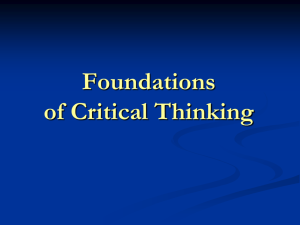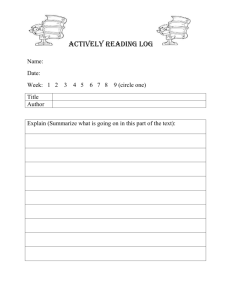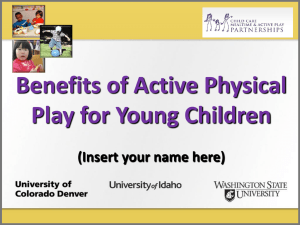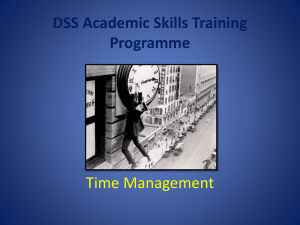What is critical thinking?
advertisement
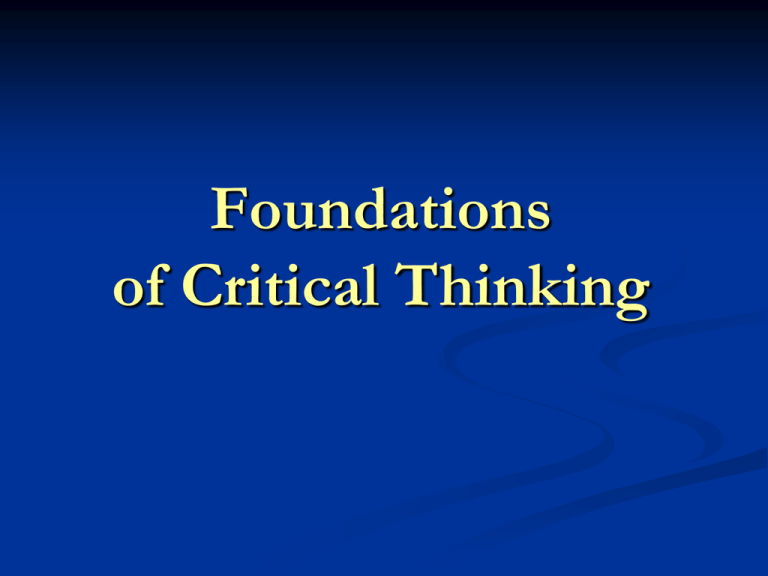
Foundations of Critical Thinking Critical Thinking What is It? Why is it Important? How Does it Improve Teaching and Learning? Critical Thinking is the art of analyzing and assessing thinking in order to improve it. Crit Critical Thinking is the awakening of the intellect to the study of itself. John Henry Newman A man may hear a thousand lectures, and read a thousand volumes, and be at the end of the process very much where he was, as regards knowledge. Something more than merely admitting it in a negative way into the mind is necessary if it is to remain there. It must not be passively received, but actually and actively entered into, embraced, mastered. The mind must go half-way to meet what comes to it from without.” Booth Tarkington, author “He had learned how to pass examinations by ‘cramming’; that is, in three or four days and nights he could get into his head enough of a selected fragment of some scientific or philosophical or literary or linguistic subject to reply plausibly to six questions out of ten. He could retain the information necessary for such a feat just long enough to give a successful performance; then it would evaporate utterly from his brain, and leave him undisturbed.” On what George Amberson had learned in college, from the Magnificant Ambersons (1918)} Whitehead, The Aims of Education “The result of teaching small parts of a large number of subjects is the passive reception of disconnected ideas, not illuminated with any spark of vitality. Let the main ideas which are introduced into a child’s education be few and important, and let them be thrown into every combination possible.” “The child should make them his own, and should understand their application here and now in the circumstances of his actual life. From the very beginning of his education, the child should experience the joy of discovery. The discovery which he has to make is that general ideas give an understanding of that stream of events which pours through his life.” Why concern ourselves with thinking? Whenever we are dealing with human life, we are almost always dealing with thinking. Thinking is the way that the mind makes sense of the world. Thinking tells us: what there is what is happening what our problems are what our options are what threatens us what is important what is unimportant who our friends are who our enemies are what our “history” is who we are who loves us Thinking determines: what we learn how we learn what we think is important to learn what effort we should expend what we think is true what we think is false how things should be viewed whether our learning is of high or low quality whether our learning is deep or superficial Everything we know, believe, want, fear and hope for, our thinking tells us. Most of the world’s problems are caused by, or exacerbated by, problems in human thinking Consider these problems Humiliation Hunger Poverty Homelessness Global Warming Torture Murder Rape Think of some problem behavior your students engage in. See if you can identify the thinking that leads to the behavior. When we place thinking at the center of instruction: we approach students as thinkers we continually seek to connect the content we are teaching to the thinking of students – illuminating how and why the content is important to them as thinkers we design instruction so that students have to think their way into and through the content. Thinking is at the core of human life and human problems Therefore thinking must be at the core of the curriculum Content is: Understood by thinking Constructed by thinking Modified by thinking Applied by thinking Questioned by thinking Assessed by thinking Therefore, to learn content students have to think it into their thinking using their thinking. Critical thinking provides the tools students need to think through content. Critical thinking is a system of thinking that opens up all other systems of thinking. What is Critical Thinking? Critical Thinking is a self-directed process by which we take deliberate steps to think at the highest level of quality. Read, write hear etc Read It Hear It Write It Substantive Learning Teach It Draw It Apply It Critical thinking is the way you do everything you do Overview slide Thinking that analyzes thinking Thinking that assesses thinking critical thinking: disciplined, self-guided thinking aimed at living a rational life. thinking that combats its native egocentricity Thinking that develops within itself intellectual habits VirtuesElements Standards Why Critical Thinking? Work in pairs. Concepts and Tools Miniguide. Person A, Person B. Critically read page 1 together, using the following method: a. Person B reads one sentence aloud, then states in his/her own words what has been read. In other words, person B interprets the sentence. b. Person A then either agrees with the interpretation or offers a different interpretation, adds to the interpretation, etc. c. During this process, do not critique what you are reading, merely interpret. d. Person B then reads the second sentence, and the same process occurs. e. Person A then takes the next two sentences, one sentence at a time, reading, interpreting, getting feedback from person B, using the same method. f. Take turns reading and interpreting using this method, each person reading and interpreting two sentences, then switching roles, until the entire page is read. Red/green thinking Red Thinking: Higher order executive functioning. Thinking that analyzes, assesses and improves green Thinking. Green Thinking: Instinctive, automatic, spontaneous thinking. Unconsciously guided Green Thinking Unconscious Mixture Of High Quality And Low Quality Thinking Spontaneous Subconscious Uncontrolled Impulsive Self protecting Unanalyzed Reflexive Self validating Includes ideas that are valid, as well as nonsense, confusion, stereotypes, prejudices. The key is that we cannot distinguish the difference between high and low quality thought in green thinking mode. Green thinking goes without assessing itself. Red Thinking Red Thinking stops and assesses itself before going forward. Disciplined Seeks the truth Self assessing Critical Thinking Self correcting Probing In red thinking mode, we actively work to eliminate prejudices, biases, dysfunctional thinking from our thinking. We actively work on our thinking. We rigorously apply intellectual standards to our thinking. Trap or free Your Thinking can either Trap You Free You Hold you Hostage within uncritically held beliefs Open your mind to new ways of thinking The critical thinking mind is the educated mind The Critical Thinking Mind = The Educated Mind To learn anything, you must actively bring it into your thinking. The Test: What is Critical Thinking? To be clear in writing: 1) state 2) elaborate (In other words…) 3) exemplify and/or illustrate Write your understanding of critical thinking, in this form: 1) 2) 3) Critical thinking is ….. In other words… For example … Think for Yourself: 1-1 Beginning to Think About Your Thinking To begin to think about your thinking, make a list of any problems you believe currently exist with your thinking. Try to be as explicit as possible. The more problems you identify the better. For each problem you identify, complete the following statements: 1. One problem with my thinking is… 2. This is a problem because… 3. If I adequately addressed this problem, the quality of my life would improve in the following ways… Think for Yourself: 1-2 Critique Your Thinking Consider your thinking in these domains of your life: at work, in personal relationships, in teaching, in intimate relationships, as a reader, as a writer, in planning your life, in dealing with your emotions, in figuring out complex situations. Complete these statements: Right now, I believe my thinking across all domains of my life is of ______________ quality. I based this judgment on _________________. 1. In the following areas, I think very well… 2. In the following areas, my thinking is OK, not great, but not terrible either… 3. In the following areas, my thinking is probably of low quality… List at least three areas for each of the above. The Quality of My Teaching is given in the thinking that I do about my Teaching What is critical thinking? Concepts and Tools Guide Silently read page 1 – then discuss. p. 2 – then discuss. p. 318 p. 4 p. 6 p. 9 p.12 p. 19 p. 18 Robert Reich, former secretary of labor for Bill Clinton Reich identifies four components of the kind of thinking that highly paid workers will increasingly need to master: 1. Command of abstractions 2. Ability to think within systems 3. Ability to evaluate ideas 4. Ability to communicate effectively What do you know about thinking? What do you know about the connection between thinking and learning? What have you learned about how you think? Did you ever study your thinking? What information do you have, for example, about the intellectual processes that occur as your mind thinks? What do you know about how to analyze, evaluate, or reconstruct your thinking? Where does your thinking come from? How much of it is of “good” quality? How much of it is of “poor” quality? Are you, in any real sense, in control of your thinking? How do you control your thinking? Do you know how to test it? Do you have any conscious standards for determining when you are thinking well and when you are thinking poorly? Have you ever discovered a significant problem in your thinking and then changed it by a conscious act of will? If anyone asked you to teach them what you have learned, thus far in your life, about thinking, would you really have any idea what that was or how you learned it? What does each of these intellectual virtues mean? Why are they important in instruction? How would you articulate the opposite of each one? The Idea of Critical Thinking Teaching strategies Typical day/Typical lessons Semester design Period of learning and experimentation Roll out across the discipline or school Analyzing the concept of “Education” What is the purpose of education? What key questions should we be asking in education (that should drive instruction)? What information should we use to determine how we should approach students/instruction? What key ideas or concepts should guide education? If we truly educate students, what are some important implications – for students and society? What should we assume, or take for granted, about what it means to be an educated person? standardselementstraits Circle – Dots
